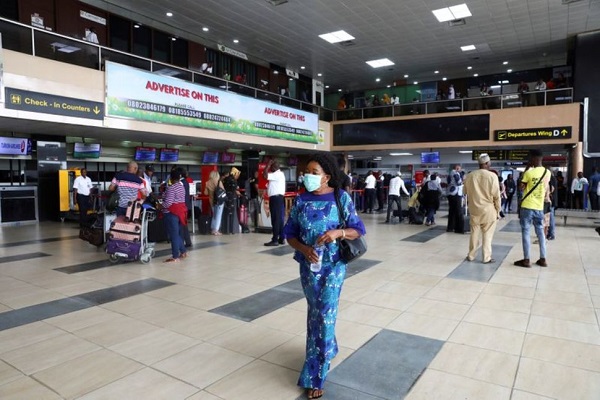 During this global disruption, airports will be required to rethink their normal business and operational processes in a few key areas.
During this global disruption, airports will be required to rethink their normal business and operational processes in a few key areas.
To reduce the spread of pathogens beyond COVID-19, airports should consider implementing autonomous, hands-free, self-processing solutions throughout the passenger journey. Already, many Common User Self Service (CUSS) solutions in the market leverage touchless biometrics, such as iris scanning and facial recognition. COVID-19 could well be the catalyst that spurs a wider adoption of touchless technologies.
The global aviation sector has never undergone a greater shock than what it is experiencing today as a result of the COVID-19 pandemic. Air travel is close to a standstill, with airlines grounding most, if not all, of their fleet due to the closure of country borders and the consequent collapse of air travel demand.
This has a knock-on effect on all other players in the ecosystem – airports are impacted by falling aeronautical and non-aeronautical revenues; air navigation service providers (ANSPs) are seeing a reduction of air traffic service charges; and ground handlers are receiving less jobs from the reduced volume of traffic through the airport.

Airports Council International (ACI) predicts that the COVID-19 pandemic will wipe out two-fifths of passenger traffic and almost half of revenues for airports in 2020. The immediate imperative of all airports is to ensure financial viability by reducing variable costs, with many airports closing portions of infrastructure, postponing capital expenditure and addressing staffing costs. Inevitably, there would be varying stages of recovery and measures imposed in airports across the world in the time to come, but the one thing is that airport operations will never be the same again.
There are many uncertainties and questions surrounding the industry now. While there is talk of new norms of airport operations that are consequential to the situation, industry practitioners are moving fast by turning to technology and new practices to prepare for what is to come.
Recovering operations with new measures
What is certain is that there will be uneven progress in recovery efforts across the world. Already, we see China seemingly having the COVID-19 pandemic under control and opening up its skies in late March 2020, only to impose new restrictions on international flights soon after to prevent imported cases. In all likelihood, domestic air travel will be the first to resume once a country feels that its internal situation is sufficiently stable.
For international air travel to get back on its feet, there must be confidence that the pandemic is under control on a global level and that it is safe to travel. Until such time when an effective solution is available, it is expected that any recovery will occur at a measured pace.
One scenario could be for countries to ramp up international flights from jurisdictions where they are confident of having a stringent regime of health controls. This would be similar to how hold baggage screening post-9/11 was streamlined through mutual recognition of other countries’ security regimes.
Another scenario that could emerge would be for countries to impose specific limitations for international passengers, including requirements before boarding, such as mandatory health screenings or COVID-19 test certificates.
Regardless of measures adopted in the hope for recovery, experts in the air transport industry expect the COVID-19 outbreak and subsequent impact on aviation to be drawn out for over a year or longer. Airport management will need to be adjusted significantly to manage changes during this period and beyond.
Adapting to a new normal
During this global disruption, airports will be required to rethink their normal business and operational processes in a few key areas.
Social distancing
Given the highly transmissible nature of COVID-19, until a vaccine is developed, social distancing will likely become the norm in airports.
The element of social distancing will fundamentally alter each passenger’s processing touchpoint, from its layout to throughput. Airports will need to review existing terminal capacity alongside new or existing terminal plans.
The additional space requirement will aggravate congestion issues faced in airports, putting those with low Levels of Service (LoS) in an even more dire state. This calls for the need to develop new expansion plans to accommodate these changes, should such requirements be mandated.
Ultimately, the impact on airport capacity is dependent on global aviation regulations, as well as the health protocols adopted by different countries.
Health screening
With uncertainty on when COVID-19 will subside, health screening is likely to be of utmost importance during this period. Technological solutions – such as electronic health declarations, thermal scanners and testing kits – need further evaluation on their effectiveness, taking precaution to not overly constrain passenger flow when introduced into the process.
Considerations span the spectrum of business continuity planning, coordination with other agencies, setting aside required testing facilities/quarantine areas and passage to an off-airport location for passengers with suspected infections.
At a tactical level, airports will need to step up with more intensive cleaning and sanitising of common space and high impact zones.
Touchless passenger processing
To reduce the spread of pathogens beyond COVID-19, airports should consider autonomous, hands-free passenger self-processing solutions throughout the passenger journey. Already, many Common User Self Service (CUSS) solutions in the market leverage touchless biometrics such as iris scanning and facial recognition. COVID-19 could well be the catalyst spurring wider adoption of touchless technologies.
Improved command and control
This pandemic has demonstrated the importance of business continuity planning and crisis management.
Apart from the typical use cases of operational efficiency in a normal operational setting, there is a clear need for command centres to support the emergency response.
Command centres have a unified view of airport operations, providing a quick and comprehensive situational awareness picture of the ground situation to key decision-makers – for instance, where arriving flights have suspected infected cases requiring urgent ground facilitation.
The timeliness and accuracy of such data in crisis management cannot be understated. There is a need to collate information quickly and accurately from multiple sources of truth for reporting.
Furthermore, with the need to limit physical proximity between staff, airports have to, more than ever, rely on virtual means of communications. Hence, it is imperative that any command and control platform be a web-based application to provide the required flexibility.
Flexibility in recovery plans
COVID-19 has seen the mass grounding of airline fleets and airports consolidating operations, to the extent of closing entire terminals to reduce overall running costs. In all likelihood, recovery by different airports could be disorderly as the pace of lifting of travel restrictions will be different across the world. Hence, it is essential to preserve maximum flexibility in recovery plans.
Coordination between the key stakeholders of airlines, ANSPs and airports would be a key challenge. For example, in aircraft rotation, grounded aircraft may be rotated between grounding and active service, introducing greater demands for engine run-ups and towing activities, amidst the need to maintain airport operations.
Airport Operations Centre as an enabler
Technology can play a vital role to aid the additional demands mentioned above. In some airports, there is already an Airport Operations Centre (APOC) set up to drive greater airport collaboration and efficiencies to cope with surging air demands and airport congestion.
While the pain points of capacity crunches may no longer be as relevant in this circumstance, the APOC’s capabilities can be adapted to support the management of COVID-19 in the following ways:
Integrated situational awareness picture both airside and in the terminal, with available sensor data that provides heat maps/reports on the terminal layout. This tracks the greatest dwell time in the terminal with detailed information on high impact zones to enable cleaning, sanitation and health/temperature screening efforts to be stepped up in identified spots
For effective multi-agency coordination, a robust messaging backbone with dedicated chat and responses for individual case incidents is needed. Airports can use the Airport Collaborative Decision Making (A-CDM) coordination structure for more seamless communications
The APOC integrates multiple data streams to form a common source of truth for timely and accurate reporting during crisis management
Be updated on evolving processes and important procedures – for example, the evacuation of potentially infected inbound travellers. To help airport personnel be up to date and familiar with these procedures, the Incident Management Tool with electronic-SOP provides a clear and easy reference of all necessary procedures
With terminal closures and grounded aircraft parking, the Course of Action modules will enable airport planners to make the most informed decision to cope with allocation decisions within curtailed terminal and airside capacity.
Taking a Proactive View
Every crisis that has challenged the aviation industry – from 9/11 to SARS – has left an indelible mark on airport and airline operations. The next 12 months will require airports to deal with a new set of challenges of a magnitude never encountered before.
It is critical not just to react, but to take a proactive, strategic posture. By harnessing innovation and the power of technology, airports should accelerate the move towards implementing an APOC at the heart of airport management and gear up for the rebound on the horizon.
 MMS PLUS NG – Maritime, Aviation, Business, Oil and Gas News Online Newspaper with coverage in Maritime, Oil and Gas, Aviation, Power and Energy as well as Financial News
MMS PLUS NG – Maritime, Aviation, Business, Oil and Gas News Online Newspaper with coverage in Maritime, Oil and Gas, Aviation, Power and Energy as well as Financial News









